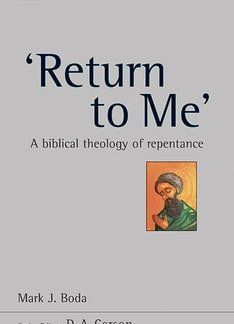Mark Boda is professor of Old Testament at McMaster Divinity College. Return to Me is volume 35 in the New Studies in Biblical Theology series. D. A. Carson is the editor of this series addressing key issues in biblical theology.
The introduction outlines the author’s convictions concerning the Scriptures and biblical theology. It also highlights Hebrew and Greek words related to repentance. Based on this initial study, repentance is defined as ‘a turn or return to a faithful relationship with God from a former state of estrangement’ (p.31). The human participation in this relationship is the core of the book.
Chapters 2-11 survey the theme of repentance throughout the Old Testament. The order of the chapters follows the order of Old Testament books.
Chapter two looks at repentance in the Torah. In this section, it is seen to be a return to a relationship with God. The purpose of repentance in this part of Scripture is to bring an end to God’s disciplinary action.
Chapter three, dealing with the former prophets, reveals a penitential pattern, ‘showing how divine discipline prompts human penitence, which in turn prompts divine mercy’ (p.52). In this section of the Bible, repentance is relational: a returning to God that involves a change in heart and behaviour.
The section on the latter prophets picks up this penitential process through the role of the prophet eliciting contrition from a wayward people. A basic structure of this penitential process emerges and the author demonstrates that discipline is used as a motivation for repentance. The author dedicates another three chapters to demonstrate how this process is worked out in the prophetic books.
The wisdom literature is seen to reveal the need for a divine enablement to repent. The issue of negative repentance or apostasy is also discussed here. Biblical books dealing with the exile and restoration emphasise another dimension. In this section repentance is prompted by various leaders, and prayer is seen as a key catalyst.
A helpful chapter addresses repentance in Old Testament theology. This chapter is enlightening and challenging in giving a comprehensive understanding of the subject.
The majority of the book focuses on the development of repentance in the Old Testament and its continuation in the New Testament. While ten chapters are dedicated to the Old Testament, only two are dedicated to the New Testament understanding of the concept. Some may find this strange, but having laid solid foundations through study of the Old Testament, the New Testament understanding becomes much clearer.
The implications of repentance are addressed in another chapter, while the value of rituals or actions are also highlighted in connection with repentance — what might be termed the fruit of repentance.
In summary, this is a comprehensive yet readable treatment of the subject. It will also help readers understand the different genres and settings of the biblical books.
Jeffrey Haskins
Lancaster




